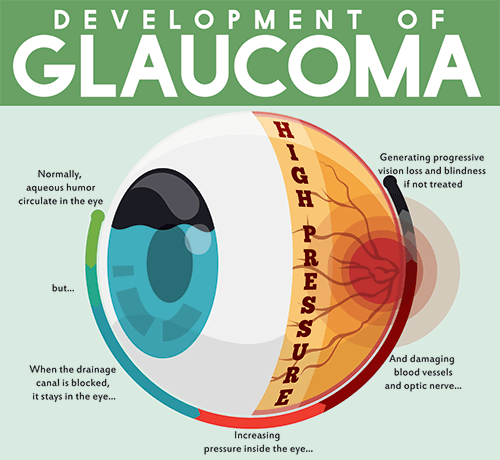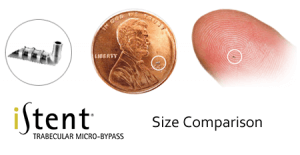There are Two Main Types Of Glaucoma:

- Open-angle glaucoma This is the most common type of glaucoma. The structures of the eye appear normal, but fluid in the eye does not flow properly through the drain of the eye, called the trabecular meshwork.
- Angle-closure glaucoma This type of glaucoma is less common but can cause a sudden buildup of pressure in the eye. Drainage may be poor because the angle between the iris and the cornea (where a drainage channel for the eye is located) is too narrow. Or, the pupil opens too wide, narrowing the angle and blocking the flow of the fluid through that channel.
Please consult with an ophthalmologist regarding glaucoma treatment options. Your Raleigh ophthalmologist will be able to diagnose the type of glaucoma and the actual severity of the Intraocular Pressure (IOP). Treatment options will drastically vary from patient to patient.
Who is at Risk For Glaucoma?
Glaucoma can affect any person regardless of family history. Regular eye exams are the only way to detect glaucoma in its early stages.
The following factors increase your risk of glaucoma:
- Increased eye pressure
- Family history of glaucoma
- African-American, Hispanic or Asian Descent
- Older than 45 years of age
- Severe Nearsightedness
- History of eye injury causing bleeding inside the eye
- Health problems including diabetes, migraine headaches, and poor circulation.
If you experience any of these symptoms, you should be evaluated by an ophthalmologist as soon as possible. Any sudden, severe eye pain or loss of vision should prompt an immediate visit to your ophthalmologist.
Regular eye exams are the only way to find glaucoma before it causes severe vision loss. The physicians at Raleigh Ophthalmology recommend the following eye exam schedule, but you should be seen more frequently if you have any of the risk factors discussed above (at least once a year).
- Age 40 and under: Once every three years
- Age 40 – 65: Once every two years
- Age 65 and over: Annually
Symptoms Of Glaucoma
With the common types of glaucoma patients have no early symptoms. Once the loss of vision is noticed, the damage is usually severe and irreversible.
Symptoms can include:
- eye pain
- blurring of vision
- colored halos around lights
- nausea and vomiting
- red eyes
- headaches
This is how glaucoma can affect vision:

Medications & Eye Drops
Glaucoma is typically treated with eye drops that decrease eye pressure either by slowing the amount of fluid produced within the eye or by improving the flow through the drainage angle. Glaucoma medications may produce side effects, so be sure to talk to your doctor if you experience any unusual symptoms.
Eye drops usually work well for most cases, but they only work if taken regularly. If the medications are forgotten, used incorrectly or taken less often than prescribed, progressive glaucoma damage may occur.
Surgery For Glaucoma
Trabeculectomy
Trabeculectomy is a surgical procedure performed by an ophthalmologist used to lower eye pressure. By trying to lower the eye pressure, damage can be halted from further pressure increases, but that damage already done is not reversible.
The trabeculectomy procedure involves the surgeon creating a tiny passageway from the inside to the outside of your eye. This helps fluid drain better from the areas it is presently not draining. Trabeculectomy can lower the pressure in your eye and help prevent more damage to the optic nerve. Trabeculectomy is more commonly used after other treatment options have not been successful or are simply not stopping the increasing IOP (Intraocular Pressure). Your Raleigh eye surgeon may consider trabeculectomy if:
- Medicines do not work as planned
- Laser surgery to lower the eye pressure has not worked
SLT – Selective Laser Trabeculoplasty
Selective Laser Trabeculoplasty (SLT) is quickly becoming a widely accepted treatment option in glaucoma treatment. SLT offers a new glimpse of hope for glaucoma patients. By engaging in this New laser technology, the ophthalmologists can now lower pressure that can possibly help a patient avoid more invasive surgery. The surgery might even reduce the dependence on medications or drops.
Selective Laser Trabeculoplasty (SLT) is an advanced laser system that improves the flow of fluid in the eye, lowering Intraocular pressure (IOP) for patients who have glaucoma. SLT uses short pulses of low energy laser light to target melanin-containing cells in a network of tiny channels, called the trabecular meshwork. The objective of the surgery is to help fluids drain out of the eye, reducing intra-ocular pressure that can cause damage to the optic nerve and loss of vision.
iStent®
 If you’ve been managing your glaucoma symptoms with medication, and now are preparing for cataract surgery, iStent® may be an ideal option for you. iStent® is a tiny implant that helps patients with glaucoma successfully manage their intraocular pressure. Performed at the time of cataract surgery, iStent® has proven to be effective in decreasing IOP, with few complications, and fast recovery time. iStent® may also reduce patients’ need for glaucoma medications.
If you’ve been managing your glaucoma symptoms with medication, and now are preparing for cataract surgery, iStent® may be an ideal option for you. iStent® is a tiny implant that helps patients with glaucoma successfully manage their intraocular pressure. Performed at the time of cataract surgery, iStent® has proven to be effective in decreasing IOP, with few complications, and fast recovery time. iStent® may also reduce patients’ need for glaucoma medications.
Goniotomy
is performed through a small incision in the trabecular meshwork, generally less than 2mm, and can be performed under topical or local-regional anesthesia. Goniotomy can be performed in conjunction with cataract surgery or as a stand-alone procedure in an out-patient facility. Goniotomy has been proven to successfully lower the intraocular pressure in most cases.
